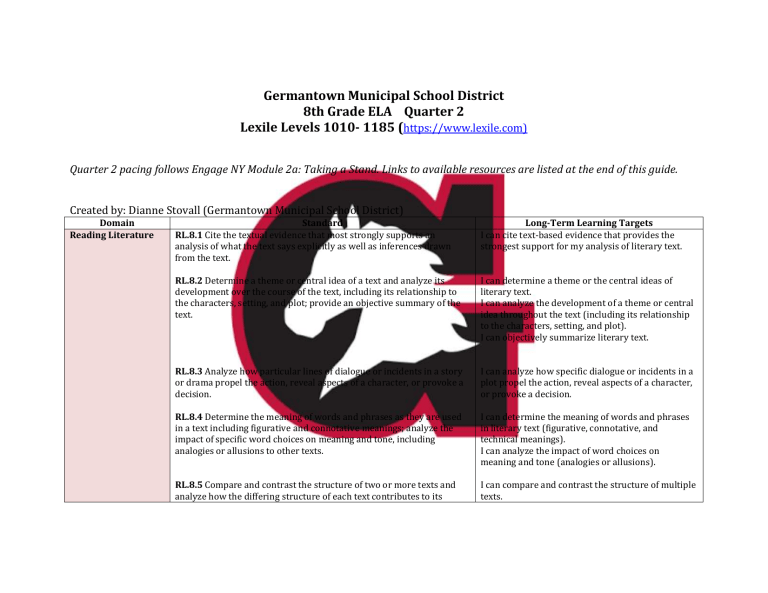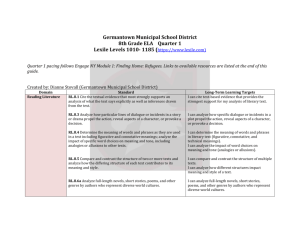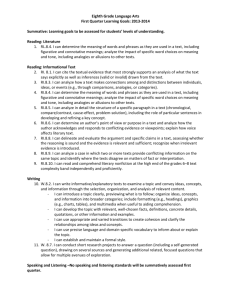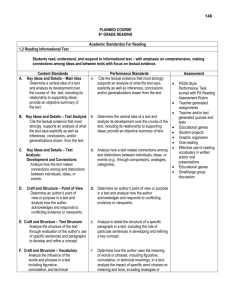Unit B - Germantown Municipal School District

Germantown Municipal School District
8th Grade ELA Quarter 2
Lexile Levels 1010- 1185 (
https://www.lexile.com)
Quarter 2 pacing follows Engage NY Module 2a: Taking a Stand. Links to available resources are listed at the end of this guide.
Created by: Dianne Stovall (Germantown Municipal School District)
Domain Standard
Reading Literature RL.8.1 Cite the textual evidence that most strongly supports an analysis of what the text says explicitly as well as inferences drawn from the text.
RL.8.2 Determine a theme or central idea of a text and analyze its development over the course of the text, including its relationship to the characters, setting, and plot; provide an objective summary of the text.
RL.8.3 Analyze how particular lines of dialogue or incidents in a story or drama propel the action, reveal aspects of a character, or provoke a decision.
RL.8.4 Determine the meaning of words and phrases as they are used in a text including figurative and connotative meanings; analyze the impact of specific word choices on meaning and tone, including analogies or allusions to other texts.
RL.8.5 Compare and contrast the structure of two or more texts and analyze how the differing structure of each text contributes to its
Long-Term Learning Targets
I can cite text-based evidence that provides the strongest support for my analysis of literary text.
I can determine a theme or the central ideas of literary text.
I can analyze the development of a theme or central idea throughout the text (including its relationship to the characters, setting, and plot).
I can objectively summarize literary text.
I can analyze how specific dialogue or incidents in a plot propel the action, reveal aspects of a character, or provoke a decision.
I can determine the meaning of words and phrases in literary text (figurative, connotative, and technical meanings).
I can analyze the impact of word choices on meaning and tone (analogies or allusions).
I can compare and contrast the structure of multiple texts.
Reading
Informational Text meaning and style.
RL.8.6 Analyze how differences in the points of view of the characters and the audience or reader (e.g., created through the use of dramatic irony) create such effects as suspense or humor.
RL.8.7 Analyze the extent to which a filmed or live production of a story or drama stays faithful to or departs from the text or script, evaluating the choices made my the director or actors.
RL.8.9 Analyze how a modern work of fiction draws on themes, patterns of events, or character types from myths, traditional stories, or religious works such as the Bible, including how the material is rendered new.
RL.8.11 Interpret, analyze, and evaluate narratives, poetry, and drama, artistically and ethically by making connections to: other texts, ideas, cultural perspectives, eras, personal events, and situations.
RI.8.1 Cite the textual evidence that most strongly supports an analysis of what the text says explicitly as well as inferences drawn from the text.
RI.8.2 Determine a central idea of a text and analyze its development over the course of the text, including its relationship to supporting
I can analyze how different structures impact meaning and style of a text.
I can analyze how difference in points of view between characters and audience create effects in writing.
I can analyze the extent to which a filmed or live production follows the text or script of the same literary text.
I can evaluate the choices made by a director or actors in presenting an interpretation of a script.
I can analyze the connections between modern fiction and myths, traditional stories, or religious works (themes, patterns of events, character types).
I can interpret, analyze, and evaluate narratives poetry, and drama, artistically and ethically by making connections to: other texts, ideas, cultural perspectives, eras, personal events, and situations.
I can select texts to read to develop personal choices in reading.
I can evaluate and make informed judgments about the quality of texts based on a set of criteria.
I can cite text-based evidence that provides the strongest support for an analysis of literary text.
I can determine a theme or the central ideas of an informational text (including its relationship to
ideas; provide an objective summary of the text.
RI.8.4 Determine the meaning of words and phrases as they are used in a text figurative, connotative, and technical meanings; analyze the impact of specific word choices on meaning and tone, including analogies or allusions to other texts.
RI.8.5 Analyze in detail the structure of a specific paragraph in a text, including the role of particular sentences in developing and refining a key concept.
RI.8.6 Determine an author’s point of view or purpose in a text and analyze how the author acknowledges and responds to conflicting evidence or viewpoints.
RI.8.7 Evaluate the advantages and disadvantages of using different mediums (e.g., print or digital text, video, multimedia) to present a particular topic or idea. supporting ideas).
I can analyze the development of a theme or central idea throughout the text (including its relationship to supporting ideas)
I can objectively summarize informational text.
I can determine the meaning of words and phrases in text (figurative, connotative, and technical meanings).
I can analyze the impact of word choice on meaning and tone (analogies and allusions).
I can analyze the structure of a specific paragraph in a text (including the role of particular sentences in developing and refining a key concept).
I can determine an author’s point of view or purpose in an informational text.
I can analyze how the author acknowledges and responds to conflicting evidence or viewpoints.
I can evaluate the advantages and disadvantages of using different mediums to present an idea.
Speaking and
Listening
Language
Daily Mountain
Language (online) has been purchased by the district.
SL.8.1 Engage effectively in a range of collaborative discussions (oneon-one, in groups, and teacher-led) with diverse partners on eighthgrade topics, texts, and issues, building on others’ ideas and expressing their own clearly.
SL.8.1a Come to discussions prepared, having read or researched material under study; explicitly draw on that preparation by referring to evidence on the topic, text, or issue to probe and reflect on ideas under discussion.
SL.8.1b Follow rules for collegial discussions and decision -making, track progress toward specific goals and deadlines, and define individual roles as needed.
SL.8.1c Pose questions that connect the ideas of several speakers, and respond to others’ questions and comments with relevant evidence, observations, and ideas.
SL.8.1d Acknowledge new information expressed by others, and, when warranted, qualify or justify their own views in light of the evidence presented.
L.8.2 Demonstrate command of the conventions of standard English capitalization, punctuation, and spelling when writing.
L.8.2a Use punctuation (comma, ellipsis, dash) to indicate a pause or break.
L.8.2b Use an ellipsis to indicate an omission.
L.8.2c Spell correctly.
L.8.4 Determine or clarify the meaning of unknown and multiplemeaning words or phrases based on grade 8 reading and content, choosing flexibly from a range of strategies.
I can effectively engage in discussions with diverse partners about eighth-grade topics, texts, and issues.
I can express my own ideas clearly during discussions.
I can build on others’ ideas during discussions.
I can use correct capitalization, punctuation, and spelling to send a clear message to my reader.
I can use a variety of strategies to determine the meaning of unknown words or phrases.
Writing
L.8.4a Use context (e.g., the overall meaning of a sentence or paragraph; a word’s position or function in a sentence) as a clue to the meaning of a word or phrase.
L.8.4b Use common, grade-appropriate Greek or Latin affixes and roots as clues to the meaning of a word (e.g., precede, recede, secede).
L.8.4c Consult general and specialized reference materials (e.g., dictionaries, glossaries, thesauruses), both print and digital, to find the pronunciation of a word, or determine or clarify its precise meaning, or its part of speech.
L.8.4d Verify the preliminary determination of the meaning of a word or phrase (e.g., by checking the inferred meaning in context or in a dictionary).
L.8.5 Demonstrate understanding of figurative language, word relationships, and nuances in word meanings.
L.8.5a Interpret figures of speech (e.g., verbal irony, puns) in context.
L.8.5b Use the relationship between particular words to better understand each of the words.
L.8.5c Distinguish among connotations (associations) of words with similar denotations (definitions) (e.g.; bullheaded, willful, firm, persistent, resolute).
W.8.1 Write arguments to support claims with clear reasons and relevant evidence.
W.8.1a Introduce claim(s), acknowledge and distinguish the claim(s) from alternate or opposing claims, and organize the reasons and evidence logically.
W.8.1b Support claim(s) with logical reasoning and relevant evidence, using accurate, credible sources and demonstrating an understanding
I can analyze figurative language, word relationships, and nuances in word meanings.
I can write arguments to support claims with clear reasons and relevant evidence.
of the topic or text.
W.8.1c Use words, phrases, and clauses to create cohesion and clarify the relationships among claim(s), counterclaims, reasons, and evidence.
W.8.1d Establish and maintain a formal style.
W.8.1e Provide a concluding statement or section that follows from and supports the argument presented.
W.8.3 Write narratives to develop real or imagined experiences or events using effective technique, relevant descriptive details, and wellstructured event sequences.
W.8.3a Engage and orient the reader by establishing a context and point of view, and introducing a narrator and/or characters; organize an event sequence that unfolds naturally and logically.
W.8.3b Use narrative techniques, such as dialogue, pacing, description, and reflection, to develop experiences, events, and/or characters.
W.8.3c Use a variety of transition words, phrases, and clauses to convey sequence, signal shifts from one time frame or setting to another, and show the relationships among experiences and events.
W.8.3d Use precise words and phrases, relevant descriptive details, and sensory language to capture the action and convey experiences and events.
W.8.3e Provide a conclusion that follows from and reflects on the narrated experiences or events.
W.8.4 Produce clear and coherent writing in which the development, organization, and style are appropriate to task, purpose, and audience.
W.8.5 With some guidance and support from peers and adults, develop
I can write narrative texts about real or imagined experiences using relevant details and event sequences that make sense.
and strengthen writing as needed by planning, revising, editing, rewriting, or trying a new approach, focusing on how well purpose and audience have been addressed.
W.8.9 Draw evidence from literary or informational text to support analysis, reflection, and research.
W.8.9a Apply grade 8 Reading Standards to literature (e.g., “Analyze how a modern work of fiction draws on themes, patterns of events, or character types from myths, traditional stories, or religious works such as the Bible, including describing how the material is rendered new”).
W.8.9b Apply grade 8 Reading standards to literary nonfiction (e.g.,
“Delineate and evaluate the argument and specific claims in a text, assessing whether the reasoning is sound and the evidence is relevant and sufficient; recognize when irrelevant evidence is introduced”).
W.8.11 Create a presentation, artwork, or text in response to a literary work with a commentary that identifies, connects and explains divergences from the original.
W.8.11a Make well-supported personal, cultural, textual, and thematic connections across genres.
W.8.11b Create poetry, stories, plays, and other literary forms (e.g., videos, artwork)
I can use evidence from literary or informational texts to support analysis, reflection, and research.
I can create a presentation, piece of artwork, or a text in response to a piece of literature.
I can comment on how my work connects to and diverges from the original literature.
Engage NY Resources: Module 2a
https://www.engageny.org/resource/grade-8-ela-module-1
Units 1, 2, and 3
The District is purchasing class sets of To Kill a Mockingbird. Schools might consider providing students the opportunity to purchase their own copies.
Central Texts:
1.
Harper Lee, To Kill a Mockingbird (New York: Warner Books, 1982). ISBN: 978-0-446-31486-2.
2.
Shirley Chisholm, “Equal Rights for Women,” speech made on May 21, 1969.
3.
Sojourner Truth, “Ain’t I a Woman?” speech made in May 1851.
4.
Lyndon Johnson, “The Great Society,” speech made on May 22, 1964.
5.
To Kill a Mockingbird, film directed by Robert Mulligan (and starring Gregory Peck), 1962.
6.
Robert Hayden, “Those Winter Sundays,” 1966.
7.
Countee Cullen, “Incident,” 1925.
8.
Ella Wheeler Wilcox, “Solitude,” 1883.
Texts differentiated by Lexile levels are listed in Module 2a Overview. http://tennessee.gov/assets/entities/education/attachments/tnready_blueprint_g8_ela.pdf







